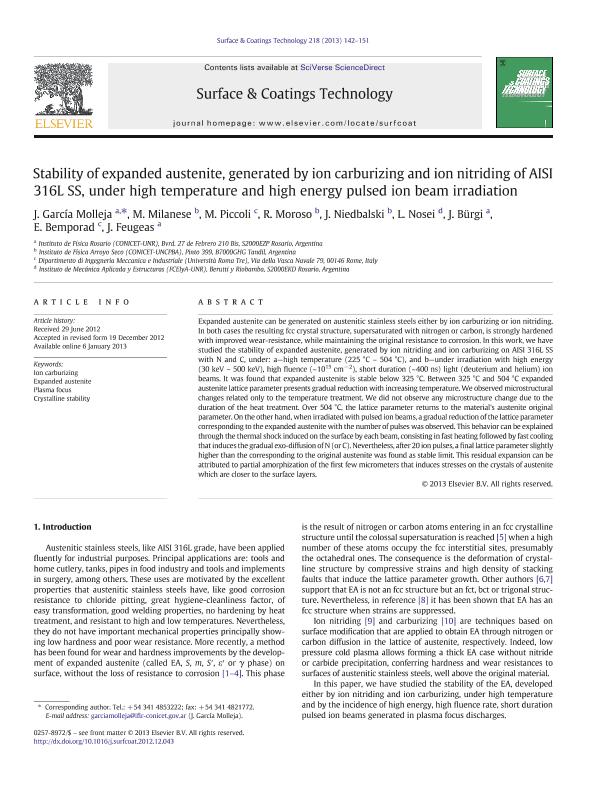Mostrar el registro sencillo del ítem
dc.contributor.author
García Molleja, J.
dc.contributor.author
Milanese, Maria Magdalena

dc.contributor.author
Piccoli, M.
dc.contributor.author
Moroso, Roberto Luis

dc.contributor.author
Niedbalski, Jorge Julio

dc.contributor.author
Nosei, L.
dc.contributor.author
Burgi, Juan Mauel

dc.contributor.author
Benporad, E.
dc.contributor.author
Feugeas, Jorge Nestor

dc.date.available
2016-03-02T17:50:15Z
dc.date.issued
2013-02
dc.identifier.citation
García Molleja, J.; Milanese, Maria Magdalena; Piccoli, M.; Moroso, Roberto Luis; Niedbalski, Jorge Julio; et al.; Stability of expanded austenite, generated by ion carburizing and ion nitriding of AISI 316L SS, under high temperature and high energy pulsed ion beam irradiation; Elsevier; Surface and Coatings Technology; 218; 2-2013; 142-151
dc.identifier.issn
0257-8972
dc.identifier.uri
http://hdl.handle.net/11336/4578
dc.description.abstract
Expanded austenite can be generated on austenitic stainless steels either by ion carburizing or ion nitriding. In both cases the resulting fcc crystal structure, supersaturated with nitrogen or carbon, is strongly hardened with improved wear-resistance, while maintaining the original resistance to corrosion. In this work, we have studied the stability of expanded austenite, generated by ion nitriding and ion carburizing on AISI 316L SS with N and C, under: a—high temperature (225 °C – 504 °C), and b—under irradiation with high energy (30 keV – 500 keV), high fluence (~ 1015 cm− 2), short duration (~ 400 ns) light (deuterium and helium) ion beams. It was found that expanded austenite is stable below 325 °C. Between 325 °C and 504 °C expanded austenite lattice parameter presents gradual reduction with increasing temperature. We observed microstructural changes related only to the temperature treatment. We did not observe any microstructure change due to the duration of the heat treatment. Over 504 °C, the lattice parameter returns to the material's austenite original parameter. On the other hand, when irradiated with pulsed ion beams, a gradual reduction of the lattice parameter corresponding to the expanded austenite with the number of pulses was observed. This behavior can be explained through the thermal shock induced on the surface by each beam, consisting in fast heating followed by fast cooling that induces the gradual exo-diffusion of N (or C). Nevertheless, after 20 ion pulses, a final lattice parameter slightly higher than the corresponding to the original austenite was found as stable limit. This residual expansion can be attributed to partial amorphization of the first few micrometers that induces stresses on the crystals of austenite which are closer to the surface layers.
dc.format
application/pdf
dc.language.iso
eng
dc.publisher
Elsevier

dc.rights
info:eu-repo/semantics/openAccess
dc.rights.uri
https://creativecommons.org/licenses/by-nc-nd/2.5/ar/
dc.subject
Ion Carburizing
dc.subject
Expanded Austenite
dc.subject
Plasma Focus
dc.subject
Crystalline Stability
dc.subject.classification
Física de los Materiales Condensados

dc.subject.classification
Ciencias Físicas

dc.subject.classification
CIENCIAS NATURALES Y EXACTAS

dc.title
Stability of expanded austenite, generated by ion carburizing and ion nitriding of AISI 316L SS, under high temperature and high energy pulsed ion beam irradiation
dc.type
info:eu-repo/semantics/article
dc.type
info:ar-repo/semantics/artículo
dc.type
info:eu-repo/semantics/publishedVersion
dc.date.updated
2016-03-30 10:35:44.97925-03
dc.journal.volume
218
dc.journal.pagination
142-151
dc.journal.pais
Países Bajos

dc.journal.ciudad
Amsterdam
dc.description.fil
Fil: García Molleja, J.. Consejo Nacional de Investigaciones Científicas y Técnicas. Centro Científico Tecnológico Rosario. Instituto de Física de Rosario (i); Argentina
dc.description.fil
Fil: Milanese, Maria Magdalena. Universidad Nacional del Centro de la Provincia de Buenos Aires. Facultad de Ciencias Exactas. Instituto de Fisica Arroyo Seco; Argentina. Consejo Nacional de Investigaciones Científicas y Técnicas. Centro Científico Tecnológico Tandil; Argentina
dc.description.fil
Fil: Piccoli, M.. Università Roma Tre. Dipartimento di Ingegneria Meccanica e Industriale; Italia
dc.description.fil
Fil: Moroso, Roberto Luis. Universidad Nacional del Centro de la Provincia de Buenos Aires. Facultad de Ciencias Exactas. Instituto de Fisica Arroyo Seco; Argentina. Consejo Nacional de Investigaciones Científicas y Técnicas. Centro Científico Tecnológico Tandil; Argentina
dc.description.fil
Fil: Niedbalski, Jorge Julio. Universidad Nacional del Centro de la Provincia de Buenos Aires. Facultad de Ciencias Exactas. Instituto de Fisica Arroyo Seco; Argentina. Consejo Nacional de Investigaciones Científicas y Técnicas. Centro Científico Tecnológico Tandil; Argentina
dc.description.fil
Fil: Nosei, L.. Universidad Nacional de Rosario. Facultad de Ciencias Exactas, Ingeniería y Agrimensura. Instituto de Mecánica Aplicada y Estructuras; Argentina
dc.description.fil
Fil: Burgi, Juan Mauel. Consejo Nacional de Investigaciones Científicas y Técnicas. Centro Científico Tecnológico Rosario. Instituto de Física de Rosario (i); Argentina
dc.description.fil
Fil: Benporad, E.. Università Roma Tre. Dipartimento di Ingegneria Meccanica e Industriale; Italia
dc.description.fil
Fil: Feugeas, Jorge Nestor. Consejo Nacional de Investigaciones Científicas y Técnicas. Centro Científico Tecnológico Rosario. Instituto de Física de Rosario (i); Argentina
dc.journal.title
Surface and Coatings Technology

dc.relation.alternativeid
info:eu-repo/semantics/altIdentifier/url/http://www.sciencedirect.com/science/article/pii/S0257897213000030
dc.relation.alternativeid
info:eu-repo/semantics/altIdentifier/doi/http://dx.doi.org/10.1016/j.surfcoat.2012.12.043
Archivos asociados
